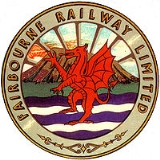
Fairbourne Railway
Encyclopedia
The Fairbourne Railway (Welsh: Rheilffordd y Friog) is a gauge miniature railway
running for 2 miles (3.2 km) from the village of Fairbourne
on the Mid-Wales coast, alongside the beach to the end of a peninsula at Barmouth Ferry
, where there is a connection with a pedestrian ferry
across the Mawddach estuary to the seaside resort of Barmouth
.
in 1867 there were lavish schemes to develop the area for tourism, the area being easily accessible to day-trippers and weekend visitors from the Midlands
.
There were several horse-drawn construction tramways in the area serving the Henddol Quarry above the neighbouring village of Friog
. The tramway that was used to construct the Fairbourne village soon introduced passenger cars to transport people to the ferry station.
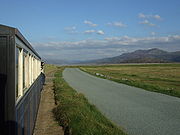 The line was converted to a 15 inch gauge steam railway in 1916 by Wenman Joseph Bassett-Lowke
The line was converted to a 15 inch gauge steam railway in 1916 by Wenman Joseph Bassett-Lowke
of Narrow Gauge Railways Ltd
(NGR). They were keen to promote tourism in the area. The railway played an important part in the development of the 15 inch gauge railways in the UK. Services were operated by Bassett-Lowke Class 10 locomotive Prince Edward of Wales designed by Henry Greenly
and passengers were conveyed in four open top carriages.
The railway had mixed fortunes during the inter war years and went through a series of changes in ownership. At one time it was leased to the ferrymen. The railway experienced motive power problems and at one stage experimented with dual gauge
track after purchasing an gauge locomotive. This was a model of a GNR Stirling 4-2-2
. A third rail was laid as far as the Golf Course.
The line closed in 1940 after operating its final year with Whippit Quick, a Lister
'Railtruck' petrol locomotive, as the steam locomotive Count Louis was out of service.
in 1946 and after rebuilding, was reopened by 1947. The line's owner John Charles Wilkins (of Wilkins & Mitchell, Darlaston), funded the redevelopment of the railway and the purchase of new steam locomotives. The line's heyday was in the 1960s and early 1970s but the advent of mass foreign holidays meant there was a steady decline in passenger numbers during the 1970s and 1980s.
 The line was sold again in 1984 to the Ellerton family and underwent dramatic changes to the infrastructure which included construction of a new station at Fairbourne and the re-gauging to 12¼ inches in 1986. Four new steam locomotives were introduced and most of the 15 inch locomotives left the site. Two of the new locomotives had run on the Réseau Guerlédan Chemin de Fer Touristique in Brittany
The line was sold again in 1984 to the Ellerton family and underwent dramatic changes to the infrastructure which included construction of a new station at Fairbourne and the re-gauging to 12¼ inches in 1986. Four new steam locomotives were introduced and most of the 15 inch locomotives left the site. Two of the new locomotives had run on the Réseau Guerlédan Chemin de Fer Touristique in Brittany
, France
in 1978. All four steam locomotives are half sized replicas of narrow gauge engines: Yeo, Sherpa, Beddgelert and Russell. Of the extant 15 in gauge locomotives only Sylvia (rebuilt as Lilian Walter) remained. Most of the 15 inch gauge locomotives are still intact and have found homes on lines around world.
In 1990 the railway built their first steam locomotive, Number 24, a replica of a locomotive from the Sandy River & Rangeley Lakes Railroad in Maine
. The locomotive has since left the line and now operates on the Cleethorpes Coast Light Railway
in Lincolnshire
.
The railway was again put up for sale in 1990 and the line's fortunes appeared to be declining once more. During the five years it was up for sale the railway deteriorated dramatically.
model railway which is gradually being added to and improved by local model engineers.
has been providing a crossing service over the Mawddach estuary and was originally operated by monks. In recent years it has been operated by independent operators. During the summer of 2007 the Railway Company acquired a ferry boat and commenced operating its own ferry service in July 2007. The new ferry boat "Y Chuff" was bought to ensure that a reliable service across the harbour to Barmouth would operate even during quiet periods of the season.
haul most of the passenger services, some of the locomotives are approximately half-size replicas of famous narrow gauge prototype locomotives such as the Class B Tanks
from the Darjeeling Himalayan Railway
and the Manning Wardle Tanks
of the Lynton and Barnstaple Railway
.
Ridable miniature railway
A ridable miniature railway is a ground-level, large scale model railway that hauls passengers using locomotives that are models of full-sized railway locomotives .-Overview:Typically they have a rail track gauge between and , though both larger and...
running for 2 miles (3.2 km) from the village of Fairbourne
Fairbourne
Fairbourne is a village on the coast of Barmouth Bay to the south of the estuary of the River Mawddach in Gwynedd, surrounded by the Snowdonia National Park. Before the seaside resort was built the coastal area was known as Morfa Henddol, while the outcrop now occupied by the Fairbourne Hotel was...
on the Mid-Wales coast, alongside the beach to the end of a peninsula at Barmouth Ferry
Barmouth Ferry railway station
Barmouth Ferry railway station is the northern terminus of the Fairbourne Railway. The station overlooks the Mawddach estuary and offers good views of the Barmouth Bridge. The passenger ferry crosses the estuary to Barmouth...
, where there is a connection with a pedestrian ferry
Barmouth Passenger ferry
The Barmouth Ferry provides a passenger service across the River Mawddach and connects the town of Barmouth with Penrhyn Point and Barmouth Ferry railway station, the northern terminus of the Fairbourne Railway. The journey takes approximately five minutes. There are two ferry operators on the...
across the Mawddach estuary to the seaside resort of Barmouth
Barmouth
Barmouth ; Y Bermo ) is a town in the county of Gwynedd, north-western Wales, lying on the estuary of the River Mawddach and Cardigan Bay.The town is served by Barmouth railway station.- History :...
.
History
The line has provided a service between Fairbourne village and Penrhyn Point since its opening in 1895 as a gauge horse-drawn construction tramway. It was converted in 1916 to gauge, and again to its present gauge in 1986. Originally built to carry building materials, the railway has carried holidaymakers for over a hundred years. At its peak in the 1970s it was carrying in excess of 70,000 passengers a year.The Early Days - Fairbourne Tramway
Following the construction of the Cambrian Coast Line in 1865 and the completion of the Barmouth BridgeBarmouth Bridge
The Barmouth Bridge is a single-track largely wooden railway viaduct that crosses the estuary of the Afon Mawddach river on the coast of Cardigan Bay between Morfa Mawddach and Barmouth in Gwynedd, Wales...
in 1867 there were lavish schemes to develop the area for tourism, the area being easily accessible to day-trippers and weekend visitors from the Midlands
English Midlands
The Midlands, or the English Midlands, is the traditional name for the area comprising central England that broadly corresponds to the early medieval Kingdom of Mercia. It borders Southern England, Northern England, East Anglia and Wales. Its largest city is Birmingham, and it was an important...
.
There were several horse-drawn construction tramways in the area serving the Henddol Quarry above the neighbouring village of Friog
Friog
Friog is a small village in North Wales, near Fairbourne.Its lake and beach are a tourist attraction to over 1,000 visitors a year.Friog is notable for a rockfall-prone section of railway track, scene of two fatal accidents on the Aberystwyth and Welsh Coast Railway line.- External links :*...
. The tramway that was used to construct the Fairbourne village soon introduced passenger cars to transport people to the ferry station.
The Pioneering Days - Fairbourne Miniature Railway

Bassett-Lowke
Bassett-Lowke was a toy company in Northampton, England, founded by Wenman Joseph Bassett-Lowke in 1898 or 1899, that specialized in model railways, boats and ships, and construction sets...
of Narrow Gauge Railways Ltd
Bassett-Lowke
Bassett-Lowke was a toy company in Northampton, England, founded by Wenman Joseph Bassett-Lowke in 1898 or 1899, that specialized in model railways, boats and ships, and construction sets...
(NGR). They were keen to promote tourism in the area. The railway played an important part in the development of the 15 inch gauge railways in the UK. Services were operated by Bassett-Lowke Class 10 locomotive Prince Edward of Wales designed by Henry Greenly
Henry Greenly
Henry Greenly was amongst the foremost miniature railway engineers of the 20th century, remembered as a master of engineering design.-Miniature railways:...
and passengers were conveyed in four open top carriages.
The railway had mixed fortunes during the inter war years and went through a series of changes in ownership. At one time it was leased to the ferrymen. The railway experienced motive power problems and at one stage experimented with dual gauge
Dual gauge
A dual-gauge or mixed-gauge railway has railway track that allows trains of different gauges to use the same track. Generally, a dual-gauge railway consists of three rails, rather than the standard two rails. The two outer rails give the wider gauge, while one of the outer rails and the inner rail...
track after purchasing an gauge locomotive. This was a model of a GNR Stirling 4-2-2
GNR Stirling 4-2-2
The Great Northern Railway No. 1 class Stirling Single is a class of steam locomotive designed for express passenger work. Designed by Patrick Stirling, they are characterised by a single pair of large driving wheels which led to the nickname "eight-footer"...
. A third rail was laid as far as the Golf Course.
The line closed in 1940 after operating its final year with Whippit Quick, a Lister
R A Lister and Company
R A Lister & Company was founded in Dursley, Gloucestershire, in 1867 by Sir Robert Ashton Lister , to produce agricultural machinery. The family was originally from Yorkshire but Ashton's father relocated to Dursley in 1817....
'Railtruck' petrol locomotive, as the steam locomotive Count Louis was out of service.
The Wilkins Era - 1947-1984
The railway was rescued by a consortium of businessmen from the MidlandsEnglish Midlands
The Midlands, or the English Midlands, is the traditional name for the area comprising central England that broadly corresponds to the early medieval Kingdom of Mercia. It borders Southern England, Northern England, East Anglia and Wales. Its largest city is Birmingham, and it was an important...
in 1946 and after rebuilding, was reopened by 1947. The line's owner John Charles Wilkins (of Wilkins & Mitchell, Darlaston), funded the redevelopment of the railway and the purchase of new steam locomotives. The line's heyday was in the 1960s and early 1970s but the advent of mass foreign holidays meant there was a steady decline in passenger numbers during the 1970s and 1980s.
The Ellerton Era - 1984-1995

Brittany
Brittany is a cultural and administrative region in the north-west of France. Previously a kingdom and then a duchy, Brittany was united to the Kingdom of France in 1532 as a province. Brittany has also been referred to as Less, Lesser or Little Britain...
, France
France
The French Republic , The French Republic , The French Republic , (commonly known as France , is a unitary semi-presidential republic in Western Europe with several overseas territories and islands located on other continents and in the Indian, Pacific, and Atlantic oceans. Metropolitan France...
in 1978. All four steam locomotives are half sized replicas of narrow gauge engines: Yeo, Sherpa, Beddgelert and Russell. Of the extant 15 in gauge locomotives only Sylvia (rebuilt as Lilian Walter) remained. Most of the 15 inch gauge locomotives are still intact and have found homes on lines around world.
In 1990 the railway built their first steam locomotive, Number 24, a replica of a locomotive from the Sandy River & Rangeley Lakes Railroad in Maine
Maine
Maine is a state in the New England region of the northeastern United States, bordered by the Atlantic Ocean to the east and south, New Hampshire to the west, and the Canadian provinces of Quebec to the northwest and New Brunswick to the northeast. Maine is both the northernmost and easternmost...
. The locomotive has since left the line and now operates on the Cleethorpes Coast Light Railway
Cleethorpes Coast Light Railway
Cleethorpes Coast Light Railway is a railway built in 1948 in Cleethorpes, North East Lincolnshire operating between Cleethorpes Leisure Centre and behind Pleasure Island/buck beck. It was originally built to a slightly smaller gauge.-History:...
in Lincolnshire
Lincolnshire
Lincolnshire is a county in the east of England. It borders Norfolk to the south east, Cambridgeshire to the south, Rutland to the south west, Leicestershire and Nottinghamshire to the west, South Yorkshire to the north west, and the East Riding of Yorkshire to the north. It also borders...
.
The railway was again put up for sale in 1990 and the line's fortunes appeared to be declining once more. During the five years it was up for sale the railway deteriorated dramatically.
Present: 1995 onwards
The current owners Professor and Mrs Atkinson and Dr & Mrs Melton bought the line in April 1995. There has since been considerable investment in the railway improving the reliability of the locomotives and the quality of the track, and a new attraction, the Rowen Centre, was set up at Fairbourne station. In 2007 some of the displays were changed to accommodate a large G scaleG scale
G scale is a scale for model railways, and because of its size and durability, G scale is often used outdoors. Such installations are known as garden railways.-LGB:...
model railway which is gradually being added to and improved by local model engineers.
Preservation Society
Like most heritage railways, the Fairbourne Railway has an active volunteer society: Fairbourne Railway Preservation Society (formerly the Fairbourne Railway Supporter's Association). The society is actively involved with the running of services and maintaining the locomotives, rolling stock, stations and track work.Ferry
For hundreds of years the ferryBarmouth Passenger ferry
The Barmouth Ferry provides a passenger service across the River Mawddach and connects the town of Barmouth with Penrhyn Point and Barmouth Ferry railway station, the northern terminus of the Fairbourne Railway. The journey takes approximately five minutes. There are two ferry operators on the...
has been providing a crossing service over the Mawddach estuary and was originally operated by monks. In recent years it has been operated by independent operators. During the summer of 2007 the Railway Company acquired a ferry boat and commenced operating its own ferry service in July 2007. The new ferry boat "Y Chuff" was bought to ensure that a reliable service across the harbour to Barmouth would operate even during quiet periods of the season.
Stations and facilities
| Image | Name | Notes |
|---|---|---|
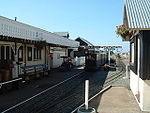 |
Fairbourne station is the main headquarters of the line and location of the locomotive and carriage sheds and workshops. There is a small museum containing many photographs of the line, a nature centre, G scale model railway, tea room, booking office and gift shop. From here trains head along Beach Road crossing over three level crossings before arriving at Beach Halt. | |
| Beach Halt serves the beach, car park and amusement arcade. The station was formerly known as "Bathing Beach" during the time as a 15 inch line. Typically, trains pass approximately 4 minutes after departing Fairbourne. From here trains head northward through the dunes, skirting the beach before arriving at Golf Halt. | ||
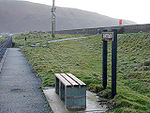 |
Golf Halt serves the 9 hole golf course and beach. Trains pass approximately 7 minutes after departing Fairbourne. From here trains continue northwards alongside the sea wall before reaching Loop Halt. | |
| Loop Halt serves the embankment footpath to Morfa Mawddach Morfa Mawddach railway station Morfa Mawddach railway station, formerly Barmouth Junction, is in Gwynedd, Wales, on the Cambrian Coast Railway between and at its junction with the Dolgelley branch of the Aberystwyth and Welsh Coast Railway part of the Ruabon to Barmouth Line which closed in 1965.- Background :North of Morfa... and the Barmouth Bridge Barmouth Bridge The Barmouth Bridge is a single-track largely wooden railway viaduct that crosses the estuary of the Afon Mawddach river on the coast of Cardigan Bay between Morfa Mawddach and Barmouth in Gwynedd, Wales... . Trains pass here approximately 9 minutes after leaving Fairbourne. Trains continue into the passing loop and during the two train service pass each other. The line then sweeps out into the sand dunes. |
||
| Estuary Halt is adjacent to the Jack Steele Tunnel and serves the car park at the end of Penrhyn Drive North. Trains pass here approximately 16 minutes after leaving Fairbourne. From here trains continue through the tunnel and more dunes before arriving at Barmouth Ferry. | ||
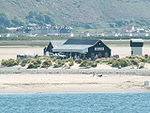 |
Barmouth Ferry is the northern terminus of the railway and is situated on a balloon loop Balloon loop A balloon loop or turning loop allows a rail vehicle or train to reverse direction without having to shunt or even stop. Balloon loops can be useful for passenger trains and unit freight trains, such as coal trains.... so the locomotives do not have to run round their trains. It is also the site of the Harbour View café and from here passengers can catch the pedestrian ferry across the estuary to Barmouth. |
|
Operation
Steam LocomotivesSteam locomotive
A steam locomotive is a railway locomotive that produces its power through a steam engine. These locomotives are fueled by burning some combustible material, usually coal, wood or oil, to produce steam in a boiler, which drives the steam engine...
haul most of the passenger services, some of the locomotives are approximately half-size replicas of famous narrow gauge prototype locomotives such as the Class B Tanks
Darjeeling Himalayan Railway
The Darjeeling Himalayan Railway, nicknamed the "Toy Train", is a narrow gauge railway from New Jalpaiguri to Darjeeling in West Bengal, run by the Indian Railways....
from the Darjeeling Himalayan Railway
Darjeeling Himalayan Railway
The Darjeeling Himalayan Railway, nicknamed the "Toy Train", is a narrow gauge railway from New Jalpaiguri to Darjeeling in West Bengal, run by the Indian Railways....
and the Manning Wardle Tanks
Yeo locomotive
Yeo was one of three narrow gauge 2-6-2T steam locomotives built by Manning Wardle in 1898 for the Lynton and Barnstaple Railway. Following the railway's closure in 1935 it was scrapped....
of the Lynton and Barnstaple Railway
Lynton and Barnstaple Railway
The Lynton & Barnstaple Railway opened as an independent railway in May 1898. It was a single track narrow gauge railway slightly over long running through the rugged and picturesque area bordering Exmoor in North Devon, England. Although opened after the 1896 Light Railways Act came into force,...
.
External links
- Official web site
- Return to the Ferry photo gallery
- Fairbourne Railway Fotopic Gallery
- Maps and photos of: Fairbourne - and Barmouth Ferry -

